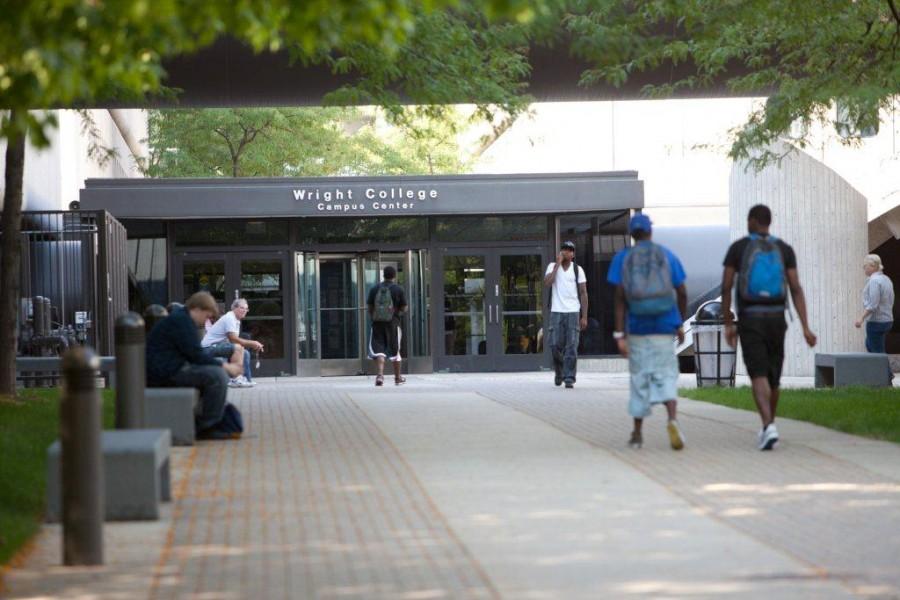#FreeCommunityCollege, #ThinkingOutLoud
Wilbur Wright College located at 4300 N Narragansett Ave
February 16, 2015
When I first saw the video of President Obama pop up on my Facebook feed with #FreeCommunityCollege, I applauded the video. So much so that I even shared it on my wall. I’ve always appreciated this president’s embrace of social media to appeal to our technology-based generation.
Isn’t community college already basically free? The Pell grant covers tuition for almost all community colleges in the country, even to the excess of about $1000 on average.
My next question was, what about me? As a recent transfer student, I did my time at community college. Can I get some free college?
I understand the reasons to choose community college. It is cheaper. Why pay anywhere from two to five times as much for essentially the same classes? I’m sure there are other reasons too. The choice for many has something to do with convenience, personal attention and class sizes as well. My community college experience provided me many, many useful and cheap transfer credits toward my ultimate goal of a Bachelor’s degree.
So far the questions that have been addressed are, why give away a free associates degree? Who’s going to want it? Why would they want it?
Those who support the proposal – properly called America’s College Promise – claim it as a way for Americans to become more industrially competitive. When so many countries like Germany, Sweden, Austria and Norway are now offering free university, even to American citizens, this would make some sense.
Supporters are also hoping to close the expansive economic gap in higher education. They’re hopeful that the “free” price tag, along with making the funding contingent on improvements in curriculum, retention and graduation rates, will draw a more economically diverse group of students and parents, thus both narrowing the gap and exposing students to a more diverse set of peers.
The proposal is calling for a joint effort on the part of the national and state legislatures. States would be funding a quarter of the project while promising to increase budgeting for higher education. This would force states to be responsible for the project’s success or failure. States that are cutting education spending, such as Illinois, with its recent cut of 30 percent in education spending, would be ineligible under this proposal for the three quarters federal subsidy to cover community college tuition.
Those who oppose the proposal are calling the “free” promise a misnomer due to its failure to address anything beyond tuition for students. An potential expansion of the Pell grant to include all students in their first two years at community college and technical career schools would still leave students with an average of $1000 to use toward living expenses. These things would include books, housing, transportation, and in an increasing number of cases child care.
Opponents are also saying that portioning funding in addition to the Pell grant without raising expectations of students’ GPA for the The College Promise proposal could lead to an abuse of the funds. Currently America’s College Promise requires students to be enrolled at least part-time and maintain a 2.0 GPA. (A 2.0 GPA is a C average.)
The current Pell grant maximum for a full-time student is $5730 divided over the course of a semester would be a little over $1400 to cover the students living expenses per month. That is equal to a little over half of the average middle class income in 2013.
Is this retroactive? At this point it is looking like a big NO! Thanks to my political science professor, I know that retroactive laws are unconstitutional. But seriously, the only way this question has been answered by the White House and the State of the Union Address this past Tuesday is by highlighting the ways that the government has already helped those of us who aren’t “green” to the college experience.
I have to point out that it’s been made very clear that this would apply only to community colleges only. Does this mean that four year universities would lose out on students coming in straight from high school? Most likely it will mean four year universities will miss out on those students trying to maximize their investment. Depending on the type of university, enrollment could go either way.
In its current condition, America’s College Promise is just a proposal, not a bill. I think government should do more to make college a standard practice for all its citizens. I agree that our government and taxes should go toward more education spending. I do think that if we give more resources – and frankly, cold hard cash – to our students they would have no reason to fail, and they would perform better. This proposal could be a good starting point, but it definitely needs work.









